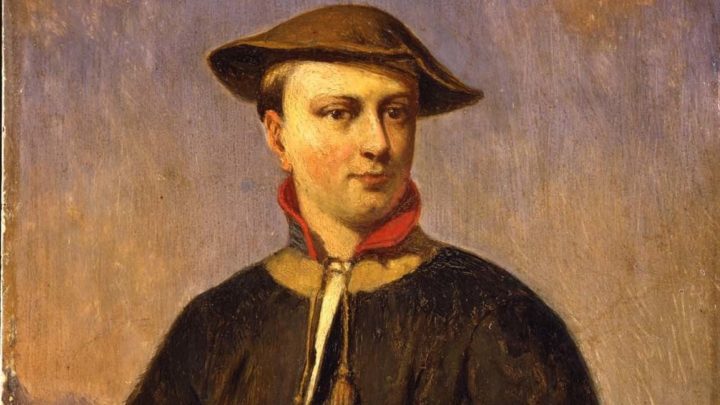Linnaeus in Lapland
Our new exhibition explores the young Carl Linnaeus' famous expedition to northern Sweden
Published on 4th February 2020
The Library is currently exhibiting a small display on 'Linnaeus in Lapland', which focuses on Carl Linnaeus' journey to Lapland between May and October of 1732. This was also the focus of our Founder’s Day lecture on 4 December (see https://www.linnean.org/meetings-and-events/events/founders-day-lecture-2019). The items on display, all from the Society's collections, include specimens of insects and plants, maps, books annotated by Linnaeus, manuscripts (including, of course, Linnaeus' famous travel diary) and even Linnaeus' walking stick!
Linnaeus’ journey began from Uppsala on Friday 12 May 1732, when Linnaeus was just 25. Over six months, Linnaeus covered over 2,000 km, in a journey that would prove significant in his scientific career.

Central case of the display, with diary, passports, walking stick and maps.

Handle of Linnaeus' walking stick.
The central case of the display focuses on the journey itself, exhibiting maps drawn by Linnaeus, passports issued to him by various regional authorities, and a copy of Johannes Scheffer, Lapponia id est, Regionis Lapponum et Gentis Nova et Verissima Descriptio (1673), which Linnaeus bought and consulted to plan his trip. The Lapland journey diary, which Linnaeus never published, takes pride of place, and is exhibited along with James Edward Smith’s English translation of 1811 (Lachesis Lapponica: A Tour in Lapland) and some of the woodcuts that reproduced Linnaeus’ idiosyncratic and sometimes naïve drawings. The Society also inherited one of Linnaeus’ walking sticks, whose handle is beautifully carved with Linnaeus’ plant, the twinflower Linnea borealis. We know from the diary that this was not the stick he used in Lapland, as this one was an ‘octangular stick, graduated for the purpose of measuring’.

Drawing of the Reindeer warble fly
The other two cases each focus on the two main themes of the diary: natural history and ethnography. The natural history of Lapland delighted Linnaeus, who was ‘like a wide-eyed child among new toys’, electrified by all the wildlife he encountered. He described about a hundred previously undescribed plants, as well as birds, fish and minerals. The details of his botanical discoveries became the basis of his book Flora Lapponica (1737). Amongst the plants and animals he described were Andromeda polifolia, also known as bog rosemary, which Linnaeus came across in the marshes not far from Umeå, and which he named Andromeda as its flower ‘reminded [him] of Andromeda as described by the poets’. Linnaeus was also particularly interested in the parasitic reindeer warble fly (Hypoderma tarandi). The larvae of this fly are a skin-penetrating ectoparasite that usually infest populations of reindeer and caribou in Arctic areas, causing harm to the hides, meat and milk in domesticated herds. Linnaeus wrote several tracts about it for the Royal Society of Science in Uppsala, on display along with a drawing and several specimens.

Specimen of Tussilago frigida (LINN 995.17)
Linnaeus was fascinated by the Saami, who guided him through the wild landscapes of Lapland. The diary is a rich ethnographical source for the Saami’s way of life in the eighteenth-century: Linnaeus describes their marriage ceremonies, their games (especially tablut), food and cooking, fishing, embroidery, tanning leather, trapping ptarmigans and shooting wolves, milking reindeer, making music and much more.
He remarked on the Saami’s heathly diets, and noted the uses of several plants such as Tussilago frigida, now Petasites frigidus, the Arctic sweet coltsfoot or Arctic butterbur, whose leaf stalks and flower stems (with flowers) are edible, and can be used as a vegetable dish.
From Lapland, Linnaeus returned with a costume in which he was famously portrayed by Martin Hoffman in 1737. Linnaeus was incredibly proud of his Saami costume: he wore it to woo his future wife Sara Lisa in 1735, and took it with him when he left for the continent that same year.

1853 copy of Hoffman's portrait of Linnaeus in Saami costume, 1737
The display will run until the end of April 2020. The Library is opened Monday to Friday, 10am to 5pm, and visitors are welcome to drop in, although it is best to check on the Library's availability (check https://www.linnean.org/research-collections or email library@linnean.org) as it is sometimes booked for functions.
Dr Isabelle Charmantier - Head of Collections
